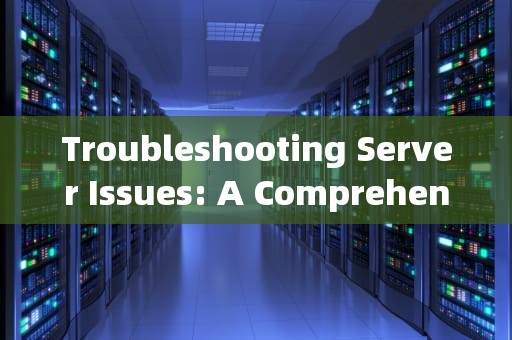Server issues can bring even the most robust operations to a grinding halt. Whether you're managing an internal corporate server or a public-facing web server, understanding how to diagnose and resolve common problems is crucial for maintaining business continuity. This guide will walk you through some of the most frequent server issues and provide actionable steps to tackle them effectively.

Common Server Problems and Their Solutions
1、Server Overload
Symptoms: Slow response times, high CPU usage, application crashes.
Causes: Too many concurrent users, insufficient resources, poorly optimized applications.
Solutions:
Scale Up: Add more RAM or upgrade the CPU.
Scale Out: Distribute the load across multiple servers using load balancers.
Optimize Code: Review and optimize your application code to make it more efficient.
Monitor Usage: Use monitoring tools to identify peak usage times and plan accordingly.
2、Network Connectivity Issues
Symptoms: Unable to connect to the server, intermittent disconnections.
Causes: Faulty network hardware, misconfigured network settings, ISP issues.
Solutions:
Check Physical Connections: Ensure all cables are securely connected.
Restart Network Devices: Power cycle routers, switches, and modems.
Verify Configuration: Double-check network settings and configurations.
Contact ISP: If the problem persists, it might be an issue with your internet service provider.
3、Disk Space Exhaustion
Symptoms: Error messages about low disk space, application failures.
Causes: Log files not being cleared, unchecked growth of data.
Solutions:
Clean Up: Remove unnecessary files, clear logs, and delete old backups.
Increase Storage: Add more disk space or upgrade to larger capacity drives.
Automate Cleanup: Set up automated scripts to clean up old files regularly.
4、Software Bugs and Updates
Symptoms: Application crashes, unexpected behavior, security vulnerabilities.
Causes: Outdated software, incompatible updates, bugs in third-party libraries.
Solutions:
Update Software: Keep your server’s operating system and applications up to date.
Patch Management: Apply patches and hotfixes as soon as they become available.
Test Before Deployment: Test updates in a staging environment before rolling them out to production.
5、Hardware Failures
Symptoms: Complete server crash, unusual noises from hardware components.
Causes: Aging hardware, power surges, manufacturing defects.
Solutions:
Regular Maintenance: Perform routine checks and maintenance on hardware components.
Redundancy: Use redundant hardware setups like RAID configurations for critical data storage.
Replace Faulty Parts: Promptly replace any failing hardware components.
6、Security Breaches
Symptoms: Unauthorized access attempts, malware infections, data breaches.
Causes: Weak passwords, outdated security protocols, zero-day exploits.
Solutions:
Use Strong Passwords: Employ complex passwords and change them regularly.
Implement Firewalls and Antivirus: Use reliable firewall and antivirus software.
Regular Audits: Conduct regular security audits and vulnerability assessments.
Encrypt Data: Use encryption for sensitive data both at rest and in transit.
7、Database Performance Issues
Symptoms: Slow query performance, database lockups, data corruption.
Causes: Inefficient queries, lack of indexing, unoptimized database schema.
Solutions:
Optimize Queries: Rewrite inefficient SQL queries and use stored procedures.
Indexing: Create indexes on frequently queried columns.
Regular Maintenance: Perform regular database maintenance tasks such as vacuuming and reindexing.
Scaling: Consider database replication and sharding for large datasets.
8、Service Configuration Errors
Symptoms: Services fail to start, applications running improperly.
Causes: Misconfiguration in service files, incorrect permissions.
Solutions:
Check Configuration Files: Ensure that configuration files are correct and properly formatted.
Permissions: Verify that the appropriate permissions are set for executables and configuration files.
Log Analysis: Examine service logs for clues about what went wrong.
Documentation: Always follow official documentation when making changes to service configurations.
9、Resource Contention
Symptoms: High resource utilization without corresponding workload, degraded performance.
Causes: Competition between processes for limited resources like CPU, memory, or I/O bandwidth.
Solutions:
Prioritize Tasks: Use Quality of Service (QoS) settings to prioritize critical applications.
Isolate Workloads: Use containerization or virtualization to isolate different workloads.
Monitor Resources: Use monitoring tools to identify and manage resource contention issues proactively.
10、Application Compatibility Issues
Symptoms: Application crashes, errors during execution.
Causes: Incompatible software versions, missing dependencies.
Solutions:
Version Control: Maintain compatibility matrices and ensure that all software versions are compatible.
Dependency Management: Use package managers to handle dependencies and ensure all necessary components are installed.
Testing: Thoroughly test applications in a staging environment before production deployment.
Advanced Troubleshooting Techniques
1、Log Analysis
What to Look For: Error messages, unusual patterns, recurring issues.
Tools: Centralized logging systems like ELK Stack (Elasticsearch, Logstash, Kibana), Splunk, or custom scripts.
Action Steps: Correlate log entries with known error codes, check for anomalies, and identify root causes.
2、Performance Monitoring
Key Metrics: CPU usage, memory usage, disk I/O, network traffic.
Tools: Nagios, Zabbix, New Relic, or built-in OS monitoring tools liketop,htop, orvmstat.
Action Steps: Set thresholds for key metrics and create alerts for when these thresholds are exceeded. Regularly review performance data to identify trends and potential issues before they escalate.
3、Root Cause Analysis (RCA)
Methodology: The "5 Whys" technique, fishbone diagrams, or fault tree analysis.
Steps: Start by identifying the symptom, then ask "Why?" repeatedly until you reach the root cause. Visual tools like fishbone diagrams can help map out possible causal factors.
Outcome: Develop actionable steps to address the root cause and prevent future occurrences.
4、Automated Diagnostic Tools
Examples: Automated scripts, AIOps platforms, machine learning algorithms.
Benefits: These tools can quickly analyze vast amounts of data to pinpoint issues, automate repetitive troubleshooting tasks, and provide predictive analytics for potential problems.
Implementation: Integrate these tools into your existing monitoring and alerting infrastructure to enhance diagnostic capabilities and reduce manual intervention.
5、Collaborative Troubleshooting
Team Involvement: Include members from development, operations, and security teams.
Communication Tools: Use collaborative platforms like Slack, Microsoft Teams, or dedicated ticketing systems.
Process: Share logs, error messages, and diagnostic findings with team members. Brainstorm possible solutions and divide tasks based on expertise to expedite resolution.
Best Practices for Server Maintenance
1、**Regular Update
随着互联网的普及和信息技术的飞速发展台湾vps云服务器邮件,电子邮件已经成为企业和个人日常沟通的重要工具。然而,传统的邮件服务在安全性、稳定性和可扩展性方面存在一定的局限性。为台湾vps云服务器邮件了满足用户对高效、安全、稳定的邮件服务的需求,台湾VPS云服务器邮件服务应运而生。本文将对台湾VPS云服务器邮件服务进行详细介绍,分析其优势和应用案例,并为用户提供如何选择合适的台湾VPS云服务器邮件服务的参考建议。

工作时间:8:00-18:00
电子邮件
1968656499@qq.com
扫码二维码
获取最新动态
